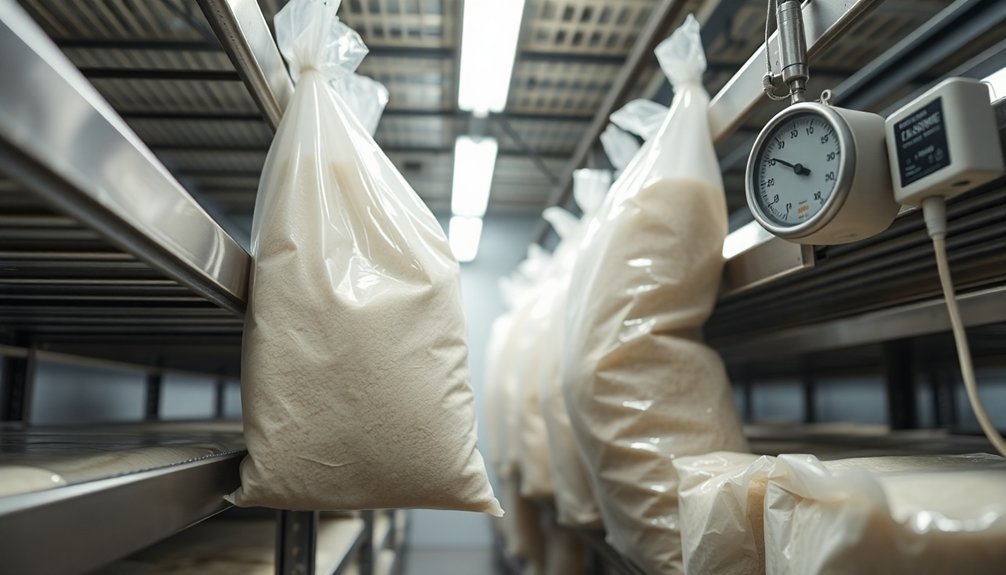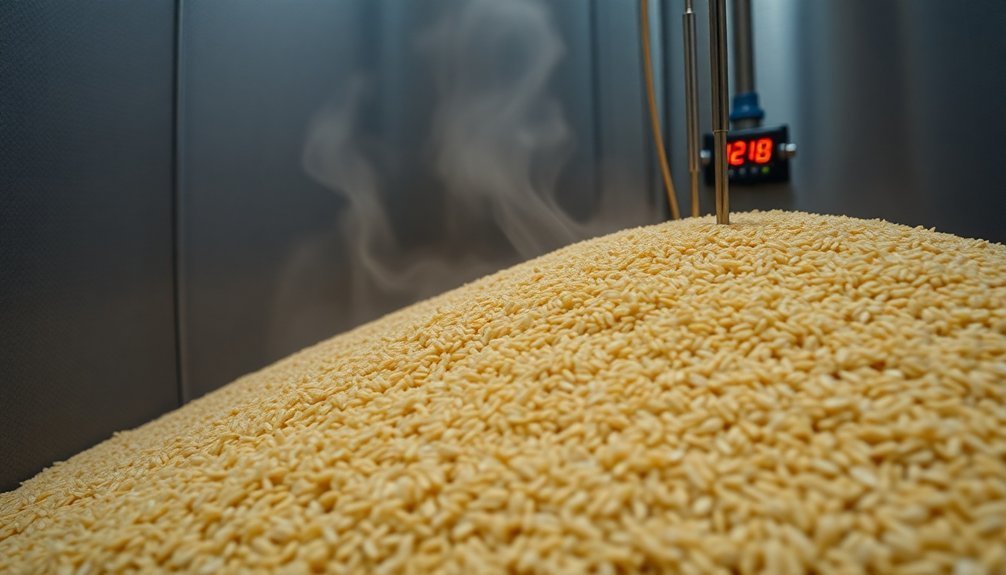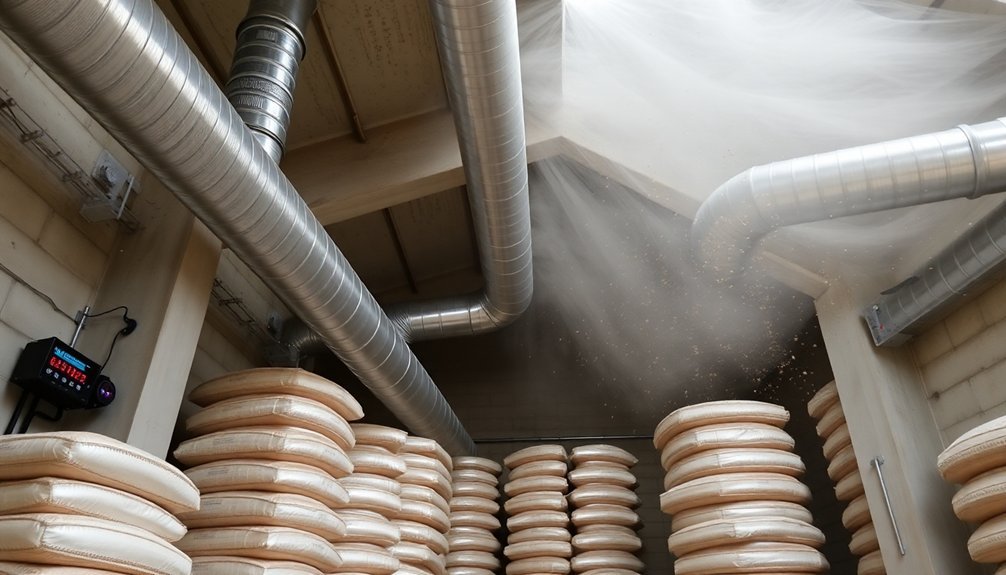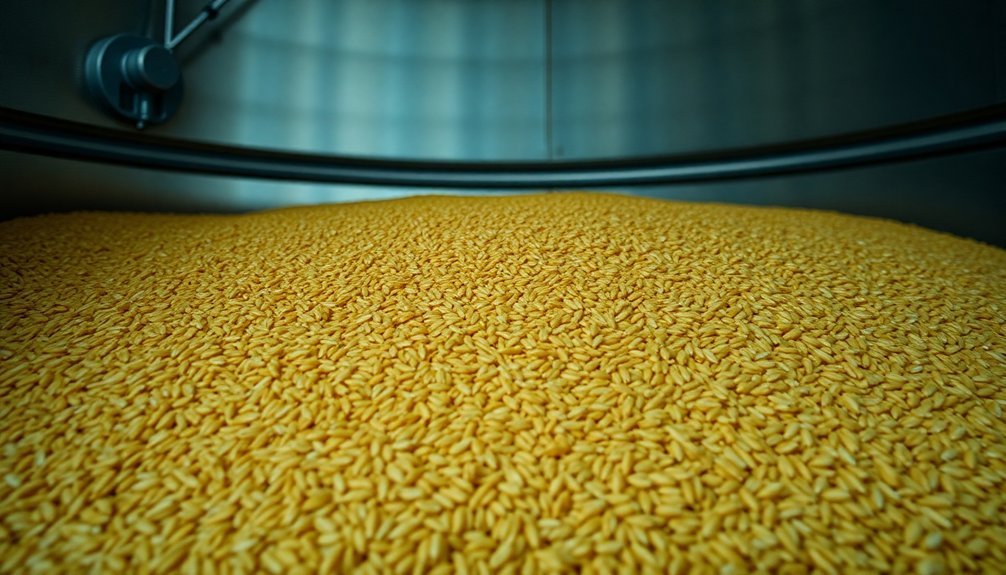You'll need multiple controls to manage rice bran moisture during storage effectively. Start with proper thermal processing at 150°C to deactivate lipase enzymes, then maintain storage temperatures below 3°C to slow moisture-related degradation. Keep relative humidity under 60% using dehumidification systems and regular monitoring. Package your rice bran in non-vacuum, metalized PET bags with aluminum coating for ideal moisture barrier protection. Target a final moisture content of 13-14% for stability, and implement continuous temperature and humidity checks. Discovering the right combination of these controls can extend your rice bran's shelf life from weeks to months.
Temperature Impact on Moisture Retention

Temperature plays an essential role in managing rice bran's moisture content during storage. You'll find that both high and low temperatures can effectively control moisture-related spoilage, though they work through different mechanisms.
When you expose rice bran to high temperatures, you're targeting the lipase enzymes that contribute to moisture-related degradation. You can achieve this through various methods: hot air heating at 150°C for 10 minutes, roasting at 150°C for 2 minutes, or steaming at 130°C for 2 minutes. These processes will reduce free fatty acids and other indicators of moisture-induced spoilage. Rice bran requires proper stabilization since its high fat content of 12-22% makes it particularly susceptible to rancidity.
If you prefer cold storage, keeping rice bran below 3°C will greatly slow down lipase activity and reduce moisture accumulation. You'll find this method particularly effective during winter months, as it can maintain rice bran stability for up to 6 months.
You can also use dry heat treatment at 110°C with 20% moisture for 5 minutes or extrusion at 130°C to deactivate problematic enzymes.
These temperature control methods don't just prevent moisture issues – they'll help maintain the bran's nutritional properties and extend its shelf life considerably.
Humidity Control Methods
You'll need both dehumidification systems and regular humidity monitoring to maintain the recommended 70% relative humidity level for rice bran storage.
Your dehumidification setup should include moisture-absorbing materials or mechanical dehumidifiers positioned strategically throughout the storage area.
For effective monitoring, install digital hygrometers at multiple points in your storage facility and check them daily to guarantee consistent humidity levels that prevent moisture-related quality deterioration. Proper humidity control helps minimize lipase activity, which causes rapid deterioration of rice bran quality.
Dehumidification Systems For Storage
Effective humidity control in rice bran storage starts with choosing the right dehumidification system. You'll need to implement desiccant dehumidifiers with cooling coils to maintain ideal moisture levels. These systems help you control both relative humidity and moisture content, which is essential for preserving rice bran quality.
While you can use aeration methods, they're not as reliable since they depend on ambient air conditions. Instead, you'll get better results with in-bin drying processes that use natural or low-temperature air. Extended storage time results in better market opportunities for sellers. To guarantee even airflow distribution, you'll want to install fans and perforated floors, which prevent hot spots from forming.
You can adapt systems used for corn and soybeans, but you'll need to make adjustments due to rice's higher resistance to airflow. For best results, maintain your storage environment at around 18°C with 70% relative humidity. This prevents hydrolytic rancidity and extends storage life.
Don't forget to monitor your static pressure regularly to guarantee adequate airflow rates. You can enhance your drying efficiency by using stirring devices, re-circulators, or automatic unloading augers. Remember to operate drying fans during low humidity hours for the most efficient results.
Humidity Monitoring Best Practices
Building on proper dehumidification systems, accurate humidity monitoring forms the backbone of successful rice bran storage.
You'll need to regularly measure relative humidity using tools like sling psychrometers to determine the equilibrium moisture content (EMC) of your rice bran. Keep the storage atmosphere's relative humidity below 60% to prevent moisture absorption.
Monitor air temperature continuously, as it directly affects the drying rate and final moisture content. You can use EMC tables to predict the moisture content your rice bran will reach based on current temperature and humidity conditions.
Install thermograph charts and humidity meters throughout your storage area to maintain consistent readings.
You should check humidity levels at least daily, focusing on areas prone to moisture buildup. When you're monitoring, pay special attention to corners and spaces between stacks where air circulation might be limited.
If you notice any sudden changes in humidity readings, investigate immediately to identify potential issues with your storage setup.
Don't forget to calibrate your monitoring equipment regularly to guarantee accurate measurements. Document all readings in a log to track patterns and identify potential problems before they affect your rice bran quality.
Proper Packaging Selection

When selecting packaging for rice bran storage, you'll want to avoid vacuum-sealed options as they can trigger lipase activation and increase FFA content through anaerobic microbial activity.
Instead, you should opt for non-vacuum, airtight packaging that maintains proper gas concentrations while preventing moisture penetration.
Metalized bags offer exceptional benefits as they create a stable internal environment by reducing gas exchange and protecting against moisture infiltration, making them an ideal choice for long-term rice bran storage.
Vacuum Vs Non-Vacuum Options
Despite its widespread use in food preservation, vacuum packaging proves counterproductive for rice bran storage, as it actually increases FFA content compared to non-vacuum alternatives. When you vacuum pack rice bran, you'll activate anaerobic microorganisms that boost lipase enzyme activity, leading to higher FFA levels. Tests show that vacuum-packed rice bran stored at 25°C experiences a dramatic FFA increase from 2.5% to 54.9% over 16 weeks.
You'll find better results with non-vacuum packaging, which maintains lower FFA content by reducing anaerobic microorganism activation. At both 18°C – 70% RH and 30°C – 78% RH storage conditions, non-vacuum packaging consistently demonstrates superior performance. The FFA content in non-vacuum packed rice bran rises more slowly, reaching 48.1% after 16 weeks at 25°C.
To optimize your rice bran storage, you'll want to combine non-vacuum packaging with proper temperature and humidity control. The ideal setup involves storing microwave-heated rice bran at 4-5°C in non-vacuum packaging.
If you're working with extruded rice bran, you'll achieve the best stability by storing it without vacuum at 18°C – 70% RH, which shows the lowest FFA values over an 8-week period.
Metalized Bag Material Benefits
Metalized bags provide superior protection compared to standard packaging options for rice bran storage.
These bags are made from PET plastic with an aluminum coating, creating a robust barrier that shields your rice bran from moisture, oxygen, and light exposure. You'll find that this specialized material helps prevent hydrolytic rancidity, which can quickly degrade your rice bran's quality.
When you're storing rice bran, you'll benefit from the bags' multiple protective features. They're puncture-resistant and tear-proof, keeping pests and contaminants out while maintaining an airtight environment once heat-sealed.
The metallic barrier effectively blocks light that could trigger oxidation and nutrient degradation, ensuring your rice bran retains its nutritional value.
You can maximize your rice bran's shelf life by storing these metalized bags in cool, dry conditions, ideally around 18°C with 70% relative humidity.
The bags' moisture control properties work together with proper storage conditions to prevent mold growth and maintain peak texture. For even better results, you can add oxygen absorbers inside the bags, creating an environment that'll keep your rice bran fresh and usable for extended periods.
Initial Moisture Assessment
Proper moisture assessment kicks off the rice bran storage process, serving as a critical first step for maintaining quality. You'll find several methods available, each with distinct advantages and specific applications.
The oven method, while time-consuming, offers reliable baseline measurements. You'll need to dry your samples at 130°C for 16 hours, being careful not to exceed this temperature to prevent chemical alterations.
For quicker results, you can use an infrared moisture balance, which follows similar weight-measurement principles but delivers faster readings.
Electronic moisture meters provide another efficient option. You'll find two main types: resistance-type meters, which are economical and use smaller samples, and capacitive meters, which offer higher accuracy but require larger samples.
Remember to verify that your meter's properly set for paddy or rough rice.
For advanced assessment, you can employ spectroscopic methods using NIR technology. You'll need to scan samples across specific wavelengths and use chemometric models like PLS for analysis.
This method's particularly precise, achieving R² values of 0.97 and SEC of 1.3% moisture, though it requires careful sample preparation and multiple scans for accurate results.
Thermal Processing Effects

You'll find that thermal processing methods like extrusion at 130°C and IR heating effectively remove excess moisture from rice bran through controlled heat application.
The extrusion process specifically reduces moisture content to 5-7% after tempering, while IR heating to 60-100°C followed by tempering helps achieve ideal moisture levels.
To maintain these moisture reductions, you must carefully monitor post-processing conditions, keeping storage temperatures at 18°C with 70% relative humidity for best results.
Moisture Removal Mechanisms
During thermal processing, moisture removal from rice bran occurs through multiple mechanisms that vary in efficiency and speed. You'll find that infrared radiation provides the fastest moisture reduction, removing about 23.24% of total moisture in under a minute. This efficiency contrasts sharply with traditional hot air drying, which requires 13 hours and multiple passes to achieve similar results.
The moisture removal process starts with adjusting the initial content to 12-13% before applying thermal treatments. You can use superheated steam at 100-110°C or an extrusion heater to reduce moisture to 8-9%. If you're using microwave heating, you'll need to maintain a higher moisture content of 20-30% at similar temperatures. For dry heat treatment, you'll want to operate at 120-130°C.
You'll notice that different mechanisms affect how quickly moisture leaves the bran. Infrared heating combines with natural cooling during tempering to remove an additional 1.2% moisture. When you're using forced draft or depressurization drying, the process takes longer but helps maintain stable moisture levels.
To guarantee proper storage stability, you'll need to achieve a final moisture content of 13-14% after all treatments are complete.
Heat Treatment Parameters
The effectiveness of thermal processing in rice bran stabilization depends on precise heat treatment parameters. You'll find that each heating method requires specific temperature, time, and moisture conditions to successfully inactivate lipase enzymes and prevent FFA formation during storage.
| Method | Temperature | Processing Time | Key Parameters |
|---|---|---|---|
| Infrared | 60-100°C | 4 hours tempering | 5000 W/m² intensity |
| Microwave | N/A | 3 minutes | 2450 MHz, 850 W |
| Dry Heat | 110-150°C | 5-10 minutes | 20% moisture |
| Steaming | 93-104°C | 5-10 minutes | High pressure |
You'll achieve ideal results with infrared heating at 60°C followed by tempering, which maintains low FFA levels for over four weeks. If you're using microwave treatment, operating at 2450 MHz for 3 minutes with 10 ml added water prevents charring while effectively deactivating lipase. For dry heat methods, you'll need temperatures of 110°C for 5 minutes with 20% moisture content. Steaming requires temperatures between 93-104°C for 5-10 minutes, while extrusion combines heat (130°C), pressure, and mechanical shear for enzyme inactivation.
Post-Processing Moisture Control
Managing moisture content after thermal processing plays an essential role in maintaining rice bran stability. You'll need to adjust the moisture content to 5-7% (w.b.) following thermal treatment to guarantee ideal stabilization.
After extrusion, you should cool the material first to room temperature (26-30°C) and then to 50°C over 24 hours to achieve proper moisture levels.
You'll get better results by storing your processed rice bran at lower temperatures and humidity levels. Storage at 18°C with 70% relative humidity will give you lower free fatty acid values compared to storage at 30°C and 78% RH.
When packaging your rice bran, don't use vacuum sealing, as it can activate anaerobic microorganisms that increase lipase enzyme activity. Instead, opt for laminated, metalized bags without vacuum.
You can extend your rice bran's shelf life considerably by maintaining these moisture control measures. While untreated rice bran deteriorates quickly due to hydrolytic rancidity, properly processed and stored rice bran can remain stable for up to 8 weeks under controlled conditions.
Remember to use sealed bags with minimal air exposure to prevent moisture absorption and lipid oxidation.
Storage Duration Guidelines
Proper storage duration management can make or break your rice bran's shelf life. You'll need to understand that raw rice bran has a relatively short shelf life of just 3-9 weeks due to its high oil content, while stabilized varieties can last up to a year when properly stored.
To maximize your rice bran's longevity, you'll want to evaluate different storage methods and their corresponding durations:
| Storage Method | Duration | Key Benefits |
|---|---|---|
| Room Temperature | 3-9 weeks | Most accessible |
| Refrigerated | 6-9 months | Extended freshness |
| Frozen | Up to 1 year | Maximum preservation |
You can greatly extend these timeframes by implementing proper stabilization techniques. If you're working with naturally preserved rice bran, expect it to last 3-6 months under ideal conditions. For even better results, you'll want to combine appropriate storage duration with ideal environmental conditions – keeping temperatures below 20°C and relative humidity under 75%. Remember to check regularly for signs of spoilage, such as off odors or unusual appearance, regardless of your chosen storage method. Don't rely solely on these guidelines; always monitor your rice bran's condition through regular quality checks.
Environmental Monitoring Systems
While storage duration guidelines provide a foundation, monitoring your rice bran's environment requires sophisticated systems and regular oversight.
You'll need to implement continuous tracking of temperature, humidity, and ventilation parameters to maintain ideal storage conditions. Modern monitoring systems should integrate sensors that alert you when conditions deviate from the perfect range of 5-25°C or when relative humidity exceeds 75%.
- Install temperature probes at multiple levels within your storage facility to detect any self-heating zones, particularly focusing on areas where temperatures might approach the critical 35-40°C range that accelerates enzyme activity.
- Deploy humidity sensors connected to automated ventilation systems, ensuring you maintain levels below 75% RH to prevent mold growth and self-heating.
- Set up CO2 and O2 monitors to track ventilation effectiveness and prevent the buildup of harmful gases that could affect storage conditions.
- Utilize data logging systems that record packaging integrity and seal status, especially for vacuum-packed or polyethylene-stored bran.
Seasonal Storage Adaptations
Seasonal changes pose unique challenges for rice bran storage that require adaptive strategies throughout the year. You'll need to adjust your storage methods based on seasonal temperature fluctuations to maintain the bran's quality and prevent rancidity.
During winter months, you're at an advantage since cooler temperatures naturally help inhibit lipase activity. You can store stabilized rice bran for up to 6 months when temperatures remain consistently low. However, you'll still need to maintain temperatures below 3°C for ideal preservation, even if ambient conditions are favorable.
In summer, you'll face greater challenges that require more active management. You must implement additional cooling measures to keep temperatures between 4-5°C, as higher temperatures around 25°C greatly increase both hydrolytic and oxidative rancidity.
You should use sealed packaging methods, such as vacuum packs or zipper-top bags, to minimize oxygen exposure year-round.
For both seasons, you'll want to combine proper temperature control with appropriate packaging. Use nonpermeable vacuum bags or polyethylene zipper-top bags, and store them at controlled temperatures to maintain lower FFA levels consistently throughout the year.
Air Circulation Requirements

Beyond seasonal adaptations, effective air circulation plays a key role in maintaining rice bran quality during storage. You'll need proper surface ventilation to prevent moisture from accumulating in your rice bran pellets, which can lead to mold growth and self-heating issues.
Good airflow helps maintain uniform temperature distribution throughout your storage bins while preventing the formation of hot spots that could compromise quality.
To maximize the benefits of air circulation, you should implement these critical requirements:
- Install insulated storage bins with controlled airflow systems to maintain consistent temperature and humidity levels
- Set up surface ventilation mechanisms that prevent moisture accumulation without over-drying the bran
- Maintain higher air flow rates during initial storage to effectively reduce grain moisture content
- Schedule periodic aeration cycles to counter extreme temperature fluctuations
You'll find that proper ventilation works hand-in-hand with temperature control. When you're storing rice bran at lower temperatures (4-5°C) and moderate humidity (70% RH), adequate air circulation becomes your primary defense against moisture-related problems.
It's crucial to monitor airflow patterns regularly and adjust ventilation rates based on storage conditions.
Moisture Barrier Technologies
The latest moisture barrier technologies provide innovative solutions for protecting stored rice bran against water vapor penetration.
Rice bran wax stands out as a premier option, delivering exceptional water vapor barrier properties with a WVTR of 5 g/m2/day at a 5 g/m2 coat weight. You'll find this performance surpasses other natural waxes like beeswax, carnauba, and rapeseed wax.
When you're considering coating methods, hot melt applications offer superior moisture protection compared to dispersion coatings, though they're more challenging to apply in thin layers.
You can enhance your moisture barrier system by combining different technologies. For instance, you'll get excellent results by protecting nanocellulose oxygen barriers with a wax coating to prevent moisture-related deterioration.
For packaging solutions, you'll want to use laminated, metalized bags without vacuum sealing.
These bags, when combined with wax-based moisture barriers, create an effective defense against humidity.
You can further optimize protection by incorporating edible moisture barrier films made from rice bran wax, beeswax, or carnauba wax.
These films don't just prevent moisture migration – they're safe for direct food contact and maintain the product's quality during storage.
Frequently Asked Questions
How Does Rice Bran Moisture Content Affect Its Nutritional Value?
You'll find that high moisture activates lipase, causing nutrient loss through rancidity. If you maintain lower moisture levels (5-7%), you'll preserve essential nutrients like vitamins, polyphenols, and tocopherols in rice bran.
Can Moldy Rice Bran Be Safely Restored Through Moisture Control Methods?
You shouldn't try to restore moldy rice bran, as it's unsafe for consumption. Once mold develops, toxins can remain even if you control moisture. It's best to discard contaminated bran entirely.
What Role Do Enzymes Play in Moisture Regulation of Stored Rice Bran?
You'll find enzymes like lipase directly influence moisture regulation by breaking down fats, creating FFAs and glycerol. Their activity increases with higher moisture content, so controlling enzyme action helps manage moisture levels in storage.
How Do Different Rice Varieties Affect Moisture Retention During Storage?
You'll find white rice retains less moisture than brown rice due to its removed bran layer. Long-grain varieties typically hold less moisture than short-grain, while aromatic rice needs extra attention to maintain proper moisture levels.
Does Rice Bran Particle Size Influence Moisture Absorption Rates During Storage?
Yes, your rice bran's particle size greatly affects moisture absorption. When you grind it finer, you'll increase surface area and hydration rates. Smaller particles absorb water faster due to their enhanced surface interaction.
In Summary
You'll need to control multiple factors to maintain proper rice bran moisture during storage. Focus on regulating temperature, humidity levels, and air circulation while using appropriate moisture barriers and packaging. Don't forget to monitor environmental conditions regularly and adapt your storage methods based on seasonal changes. Your initial moisture assessment and thermal processing choices will greatly impact long-term storage success.





Leave a Reply